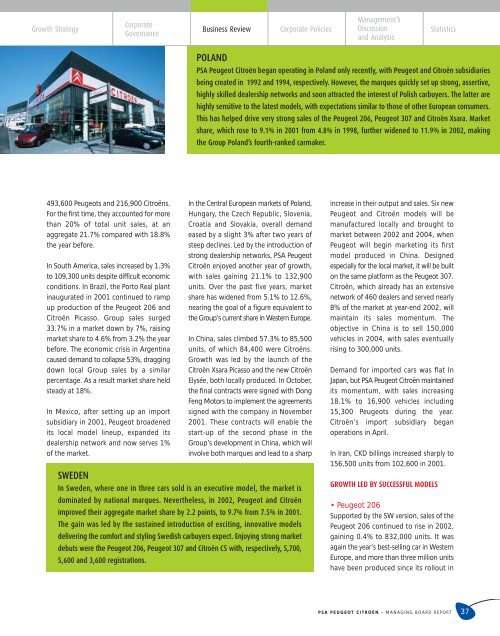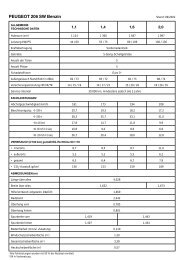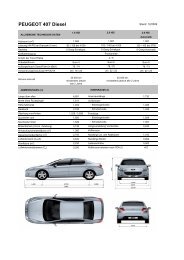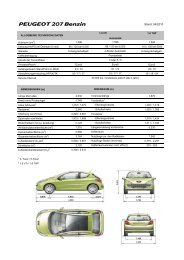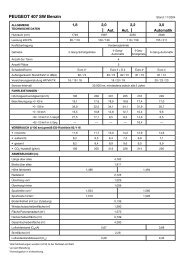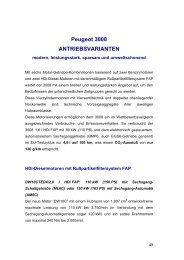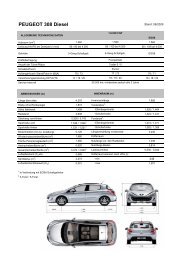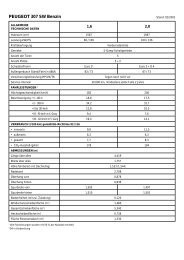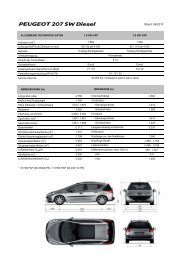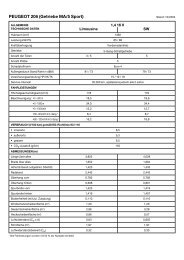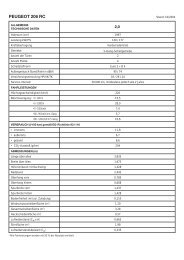PSA COUV page . page RA GB - PEUGEOT Presse
PSA COUV page . page RA GB - PEUGEOT Presse
PSA COUV page . page RA GB - PEUGEOT Presse
Create successful ePaper yourself
Turn your PDF publications into a flip-book with our unique Google optimized e-Paper software.
Growth Strategy<br />
Corporate<br />
Governance<br />
Business Review<br />
Corporate Policies<br />
Management’s<br />
Discussion<br />
and Analysis<br />
Statistics<br />
POLAND<br />
<strong>PSA</strong> Peugeot Citroën began operating in Poland only recently, with Peugeot and Citroën subsidiaries<br />
being created in 1992 and 1994, respectively. However, the marques quickly set up strong, assertive,<br />
highly skilled dealership networks and soon attracted the interest of Polish carbuyers. The latter are<br />
highly sensitive to the latest models, with expectations similar to those of other European consumers.<br />
This has helped drive very strong sales of the Peugeot 206, Peugeot 307 and Citroën Xsara. Market<br />
share, which rose to 9.1% in 2001 from 4.8% in 1998, further widened to 11.9% in 2002, making<br />
the Group Poland’s fourth-ranked carmaker.<br />
493,600 Peugeots and 216,900 Citroëns.<br />
For the first time, they accounted for more<br />
than 20% of total unit sales, at an<br />
aggregate 21.7% compared with 18.8%<br />
the year before.<br />
In South America, sales increased by 1.3%<br />
to 109,300 units despite difficult economic<br />
conditions. In Brazil, the Porto Real plant<br />
inaugurated in 2001 continued to ramp<br />
up production of the Peugeot 206 and<br />
Citroën Picasso. Group sales surged<br />
33.7% in a market down by 7%, raising<br />
market share to 4.6% from 3.2% the year<br />
before. The economic crisis in Argentina<br />
caused demand to collapse 53%, dragging<br />
down local Group sales by a similar<br />
percentage. As a result market share held<br />
steady at 18%.<br />
In Mexico, after setting up an import<br />
subsidiary in 2001, Peugeot broadened<br />
its local model lineup, expanded its<br />
dealership network and now serves 1%<br />
of the market.<br />
In the Central European markets of Poland,<br />
Hungary, the Czech Republic, Slovenia,<br />
Croatia and Slovakia, overall demand<br />
eased by a slight 3% after two years of<br />
steep declines. Led by the introduction of<br />
strong dealership networks, <strong>PSA</strong> Peugeot<br />
Citroën enjoyed another year of growth,<br />
with sales gaining 21.1% to 132,900<br />
units. Over the past five years, market<br />
share has widened from 5.1% to 12.6%,<br />
nearing the goal of a figure equivalent to<br />
the Group’s current share in Western Europe.<br />
In China, sales climbed 57.3% to 85,500<br />
units, of which 84,400 were Citroëns.<br />
Growth was led by the launch of the<br />
Citroën Xsara Picasso and the new Citroën<br />
Elysée, both locally produced. In October,<br />
the final contracts were signed with Dong<br />
Feng Motors to implement the agreements<br />
signed with the company in November<br />
2001. These contracts will enable the<br />
start-up of the second phase in the<br />
Group’s development in China, which will<br />
involve both marques and lead to a sharp<br />
SWEDEN<br />
In Sweden, where one in three cars sold is an executive model, the market is<br />
dominated by national marques. Nevertheless, in 2002, Peugeot and Citroën<br />
improved their aggregate market share by 2.2 points, to 9.7% from 7.5% in 2001.<br />
The gain was led by the sustained introduction of exciting, innovative models<br />
delivering the comfort and styling Swedish carbuyers expect. Enjoying strong market<br />
debuts were the Peugeot 206, Peugeot 307 and Citroën C5 with, respectively, 5,700,<br />
5,600 and 3,600 registrations.<br />
increase in their output and sales. Six new<br />
Peugeot and Citroën models will be<br />
manufactured locally and brought to<br />
market between 2002 and 2004, when<br />
Peugeot will begin marketing its first<br />
model produced in China. Designed<br />
especially for the local market, it will be built<br />
on the same platform as the Peugeot 307.<br />
Citroën, which already has an extensive<br />
network of 460 dealers and served nearly<br />
8% of the market at year-end 2002, will<br />
maintain its sales momentum. The<br />
objective in China is to sell 150,000<br />
vehicles in 2004, with sales eventually<br />
rising to 300,000 units.<br />
Demand for imported cars was flat In<br />
Japan, but <strong>PSA</strong> Peugeot Citroën maintained<br />
its momentum, with sales increasing<br />
18.1% to 16,900 vehicles including<br />
15,300 Peugeots during the year.<br />
Citroën’s import subsidiary began<br />
operations in April.<br />
In Iran, CKD billings increased sharply to<br />
156,500 units from 102,600 in 2001.<br />
GROWTH LED BY SUCCESSFUL MODELS<br />
• Peugeot 206<br />
Supported by the SW version, sales of the<br />
Peugeot 206 continued to rise in 2002,<br />
gaining 0.4% to 832,000 units. It was<br />
again the year’s best-selling car in Western<br />
Europe, and more than three million units<br />
have been produced since its rollout in<br />
<strong>PSA</strong> <strong>PEUGEOT</strong> CITROËN - MANAGING BOARD REPORT 37


